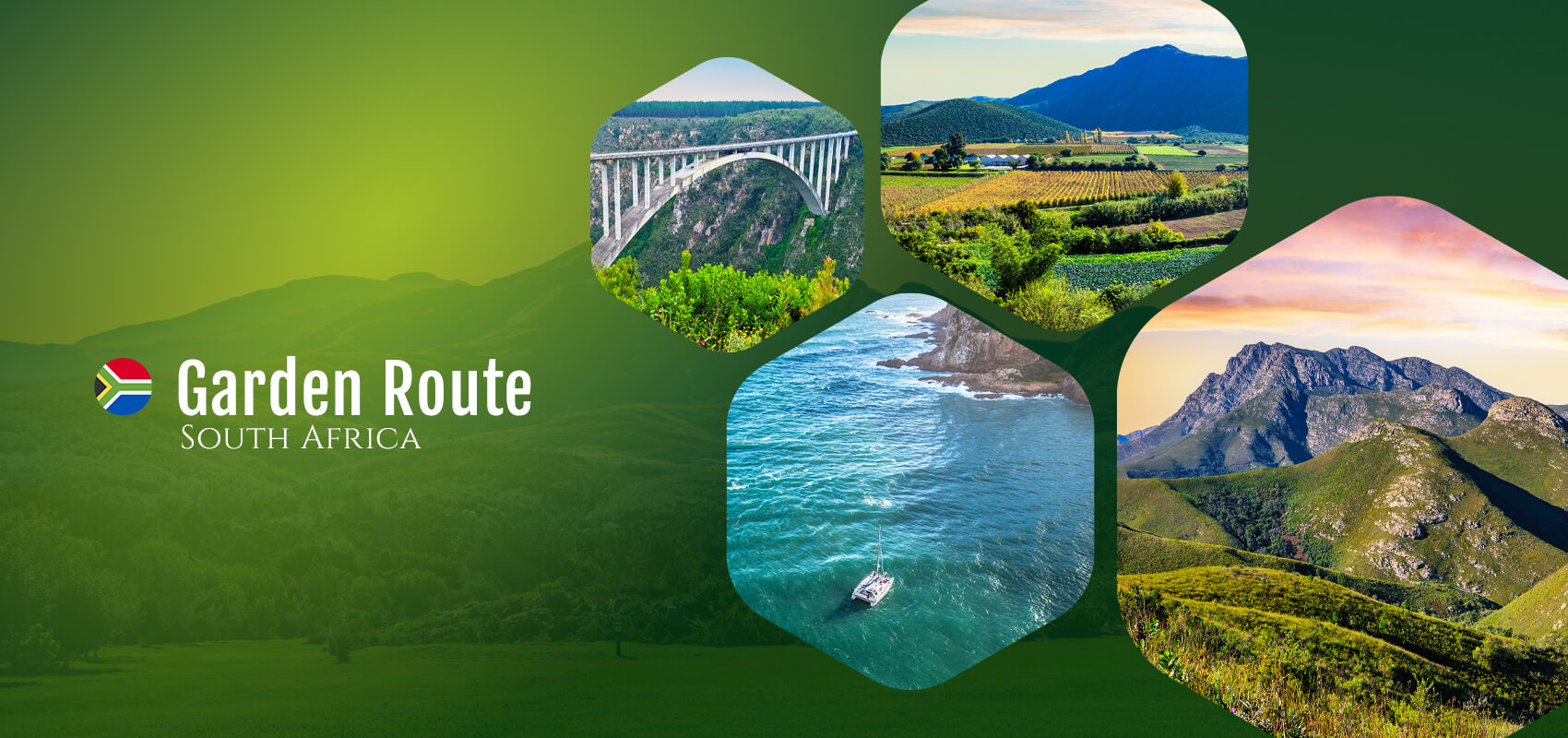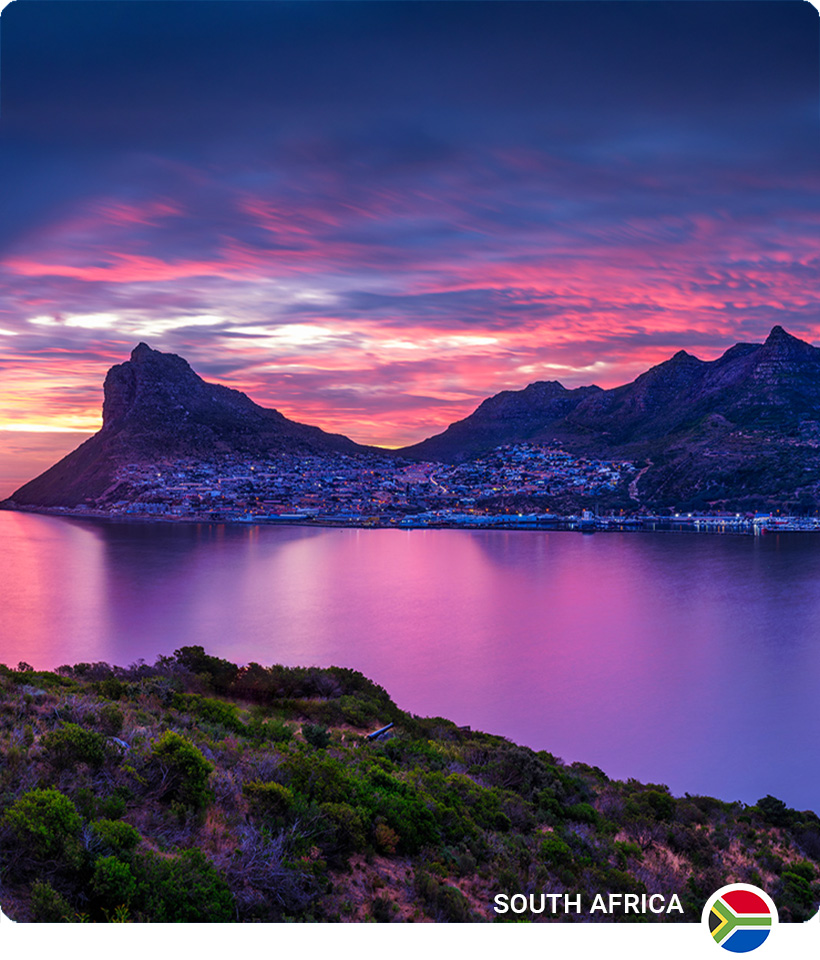Welcome to one of South Africa’s most iconic journeys: the legendary Garden Route! Stretching approximately 300km along the sun-kissed south-eastern coastline of the Western Cape, this world-renowned road trip paradise weaves between the majestic Outeniqua and Tsitsikamma mountains and the sparkling Indian Ocean. Prepare to explore a breathtaking mosaic of landscapes – from ancient indigenous forests and tranquil lagoons to golden beaches and dramatic cliffs. Often hailed as a must-do South African travel experience, the Garden Route promises scenery that will leave you spellbound.
But the Garden Route offers far more than just captivating scenery. It’s an adventurer’s playground and a nature lover’s sanctuary, bursting with diverse activities and experiences for every kind of tourist. Imagine hiking through ancient forests, kayaking on serene lagoons, exploring the vast Cango Caves, relaxing on pristine beaches, encountering elephants at a sanctuary, or seeking thrills with the world’s highest bridge bungee jump. Beyond the well-trodden path, charming towns like Knysna, Plettenberg Bay, and Wilderness hold their own allure, and this guide will help you uncover some of the Garden Route’s best kept secrets and local tips along the way.
Perfect for families and all travellers, this stunning region is also conveniently malaria-free. Ready to discover the magic? This ultimate travel guide, designed to complement our video “Garden Route best kept secrets, a local’s guide to hidden gems,” is your essential companion. Let’s begin exploring the wonders of the Garden Route!
Planning Your Garden Route Adventure: Essential Tips & Safety Advice
Before you begin on your Garden Route road trip, here’s some practical advice and crucial safety information to ensure a smooth and enjoyable journey:
Best Time to Visit:
- The Garden Route is great year-round, but seasons offer trade-offs.
- Summer (Nov-Apr): Best for beaches and warm weather, but expect peak crowds and prices (especially Dec/Jan). February/March offer similar weather with fewer people
- Winter (Jun-Aug): Coolest, potentially rainy (especially west), but fewest crowds and lowest prices. Prime time for whale watching (starts June/July) and the Knysna Oyster Festival (July).
- Autumn (Mar-May) & Spring (Sep-Nov): Often considered ideal, with pleasant weather, fewer crowds (except holidays), and good conditions for hiking. Spring features wildflowers and peak whale watching.
Trip Duration:
- While the core route is short, rushing misses the point.
- Allow at least 4-5 days for key highlights.
- 7-10 days is often recommended for a more relaxed pace, deeper exploration, and potential detours (like Oudtshoorn). Factor in driving time from your starting point (e.g., Cape Town).
Getting Around:
- Self-driving offers the most flexibility to explore at your own pace.
- The main N2 highway is generally well-maintained. A standard car is usually sufficient, but higher clearance can be better for gravel roads.
- Offline Maps are Essential: Cell phone signal can be very unreliable in mountains, forests, and parks. Download maps using apps like MAPS.ME or Google Maps offline feature before you travel. Don’t rely solely on live navigation.
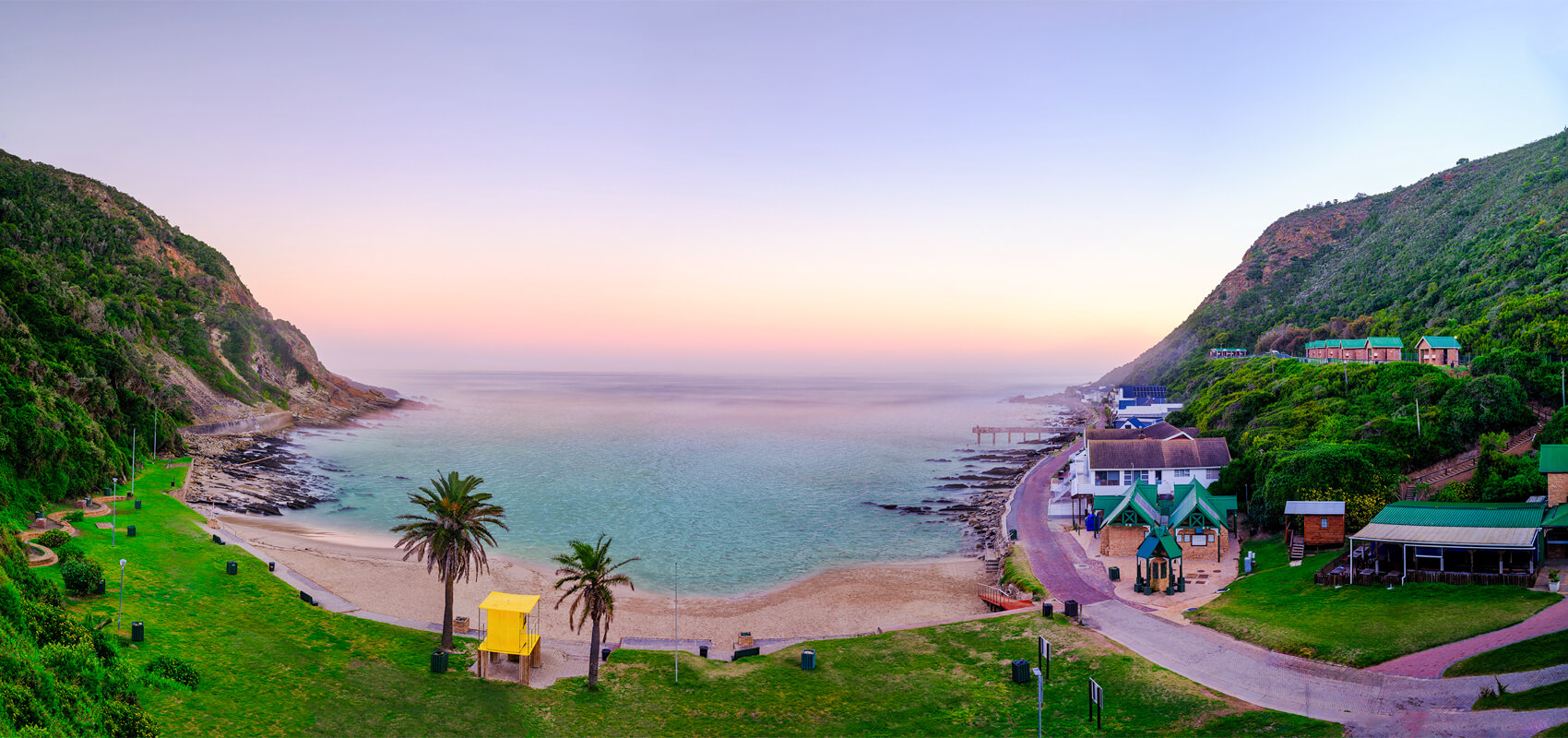 Picturesque Victoria Bay located near George, a serene coastal destination in the Garden Route.
Picturesque Victoria Bay located near George, a serene coastal destination in the Garden Route.
Packing Essentials:
- Layers: Pack for variable weather – t-shirts, long sleeves, fleece/sweater.
- Waterproof Jacket: Essential due to the possibility of rain year-round.
- Comfortable Shoes: Essential for walking/light trails; hiking boots if planning strenuous hikes.
- Sun Protection: High SPF sunscreen, wide-brimmed hat, sunglasses are crucial.
- Insect Repellent: Useful especially near water or forests in the evenings.
- Cash (ZAR): Needed for entrance fees at some parks/attractions and smaller stalls, although cards are widely accepted elsewhere.
- Other: Swimsuit, camera, binoculars, reusable water bottle, basic first-aid kit.
Driving Rules & Safety:
- Drive on the LEFT, as the steering wheel positioned on the right side of the vehicle.
- Speed Limits: Generally 60 km/h (urban), 100 km/h (rural roads), 120 km/h (freeways), unless otherwise signposted. Speed cameras are common.
- Alcohol: Strict limits (0.05% BAC); safest approach is ZERO alcohol if driving.
- AVOID NIGHT DRIVING: Strongly advised due to poor visibility of hazards (potholes, animals) and increased security risks. Plan to arrive before dark.
- Vehicle Security: Keep doors locked while driving and parked. Keep valuables completely out of sight – lock them in the boot before arriving at your destination.
- Parking: Park in well-lit, secure areas. Be aware of your surroundings. Tipping informal car guards (R5-R20 depending on duration) is customary in many places.
- Hazards: Watch for potholes, pedestrians, domestic animals (cows, goats often unfenced), wildlife (especially dawn/dusk), and potentially unpredictable minibus taxis.
- Stopping: Avoid pulling over in isolated areas; use designated viewpoints or busy public places.
- GPS Caution: Stick to main numbered roads (N2, R-roads) if unsure; don’t blindly follow GPS shortcuts through unfamiliar areas or townships.
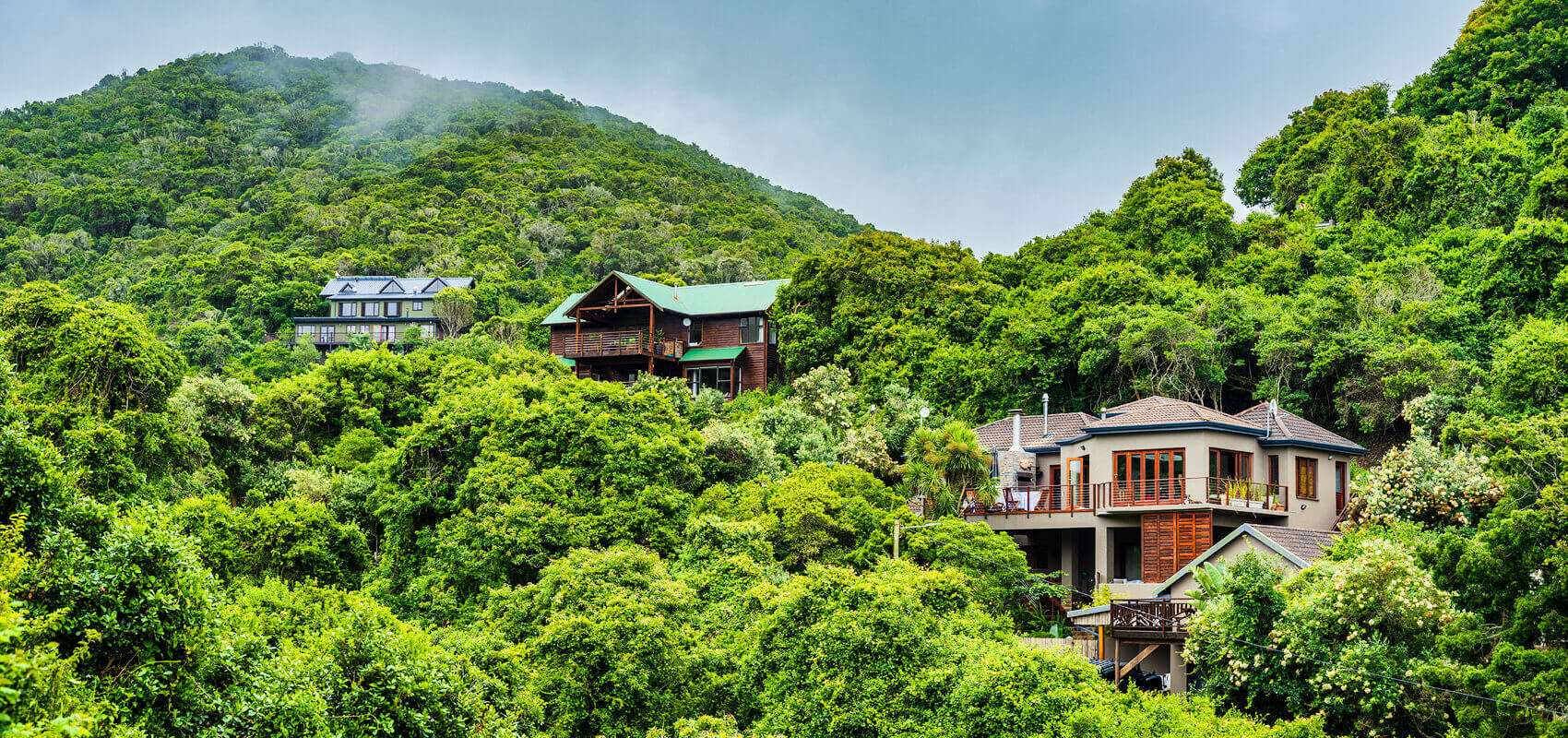 Breathtaking views of Wilderness, a serene stop on the Garden Route in South Africa.
Breathtaking views of Wilderness, a serene stop on the Garden Route in South Africa.
Health Notes:
- Malaria-Free: The Garden Route is entirely malaria-free; no anti-malarial medication is required.
- Water: Stick to bottled water for drinking to be safe, especially if sensitive, although tap water in major towns is generally treated.
- Vaccinations: Ensure routine shots are up-to-date; consult a travel clinic about others (e.g., Hepatitis A) well in advance.
- Travel Insurance: Comprehensive medical and travel insurance is essential.
Emergency Numbers (Nationwide):
- Police: 10111
- Ambulance: 10177
- Emergency from Mobile Phone: 112 (Connects to network’s emergency centre)
1. Mossel Bay: Where History Meets the Sea
Our Garden Route adventure officially begins in Mossel Bay, the historical starting point of this famed coastal drive. While sometimes seen as just a gateway, this harbour town offers a fascinating mix of deep history, beautiful beaches, and modern adventure. Its significance stretches back millennia, with nearby Pinnacle Point caves revealing some of the earliest evidence of modern human behaviour. Mossel Bay also holds a key place in maritime history as the spot where Portuguese explorer Bartolomeu Dias first landed in South Africa in 1488.
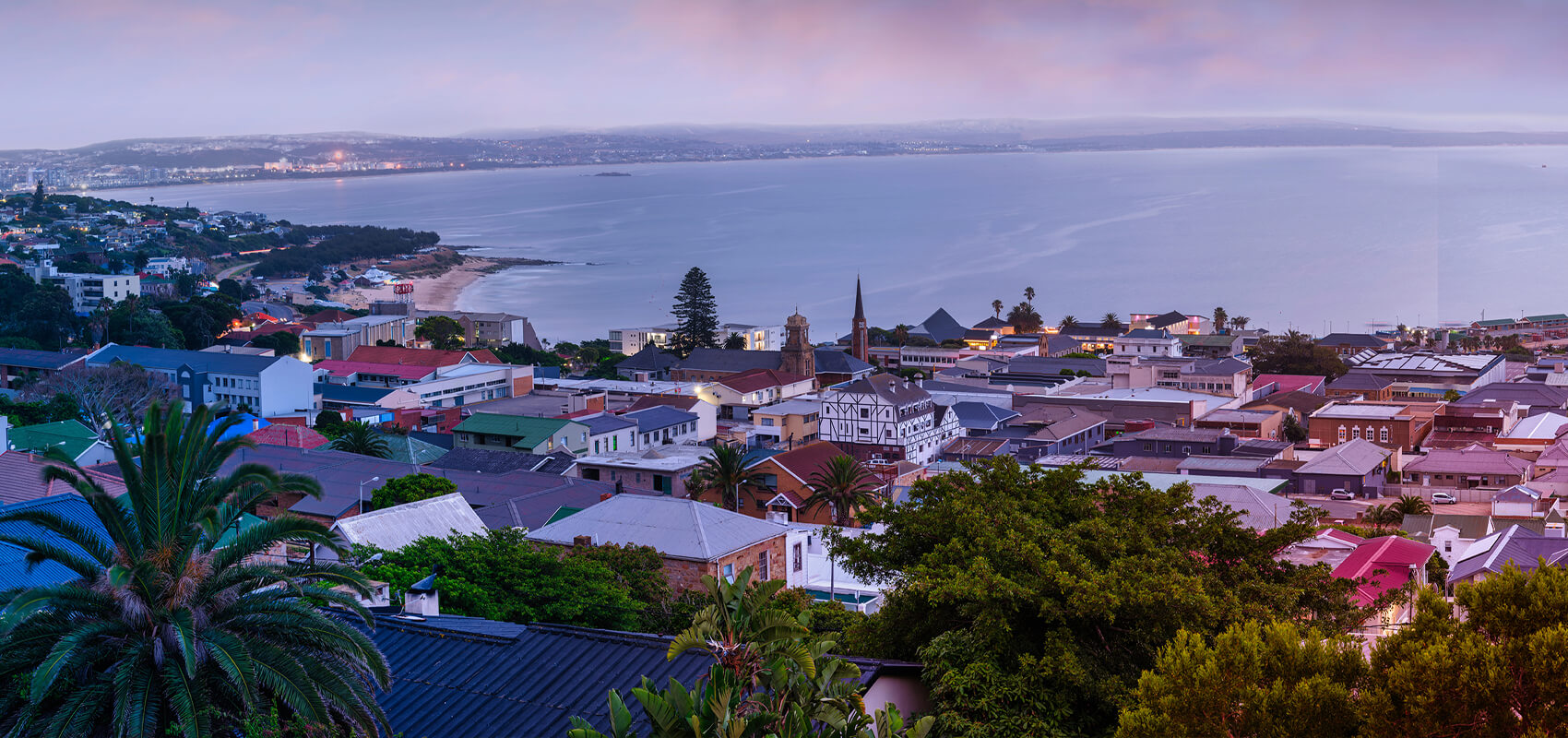 Breathtaking ocean views and golden beaches in Mossel Bay, Garden Route, South Africa.
Breathtaking ocean views and golden beaches in Mossel Bay, Garden Route, South Africa.
Dive into this rich past at the excellent Bartolomeu Dias Museum Complex. The highlight here is undoubtedly the full-scale, seaworthy replica of Dias’s caravel, the ship that navigated these waters over 500 years ago. Don’t miss the unique Post Office Tree, an ancient milkwood used by sailors centuries ago to leave letters – a tradition you can continue today by posting your own mail in the boot-shaped postbox beneath it. For panoramic views, head up to the Cape St. Blaize Lighthouse precinct; from here, you can also take a walk along the start of the scenic St. Blaize Hiking Trail that hugs the cliffs.
Beyond history, Mossel Bay invites relaxation and excitement. Enjoy the warm Indian Ocean waters at pristine beaches like Santos Beach, which boasts Blue Flag status. You can try surfing the turquoise waves or, for a serious adrenaline rush, tackle the Mossel Bay Zipline, famous for being the longest over-ocean zipline in the world!
Tips for Visiting Mossel Bay:
- Dias Museum Complex: A must-visit for history. Allow a good couple of hours to explore the different buildings (Maritime Museum, Shell Museum etc.) and participate in the Post Office Tree tradition. Link: Dias Museum Complex
- Cape St. Blaize: Great spot for coastal views from the lighthouse area. Consider a short, scenic walk along the beginning section of the St. Blaize Trail.
- Beaches: Santos Beach is known for being family-friendly and safe for swimming.
- Zipline: Experience the unique thrill of ziplining high above the ocean waves. Link: Mossel Bay Zipline
- Point of Human Origins: For those fascinated by paleoanthropology, book a guided tour (essential) to the Pinnacle Point caves. Link: Point of Human Origins
- Whale Watching: Boat trips are available, with the peak season running from June to November.
- General Info: For more details on accommodation and activities. Link: Mossel Bay Tourism
2. George: Gateway to Mountains, Gardens & Golf
Moving east from Mossel Bay, we arrive at George, the administrative capital and largest town along the Garden Route. Nestled at the foot of the majestic Outeniqua Mountains, George serves as a central hub with excellent amenities, including the region’s main airport, making it a practical base for exploring both the coast and the nearby mountains.
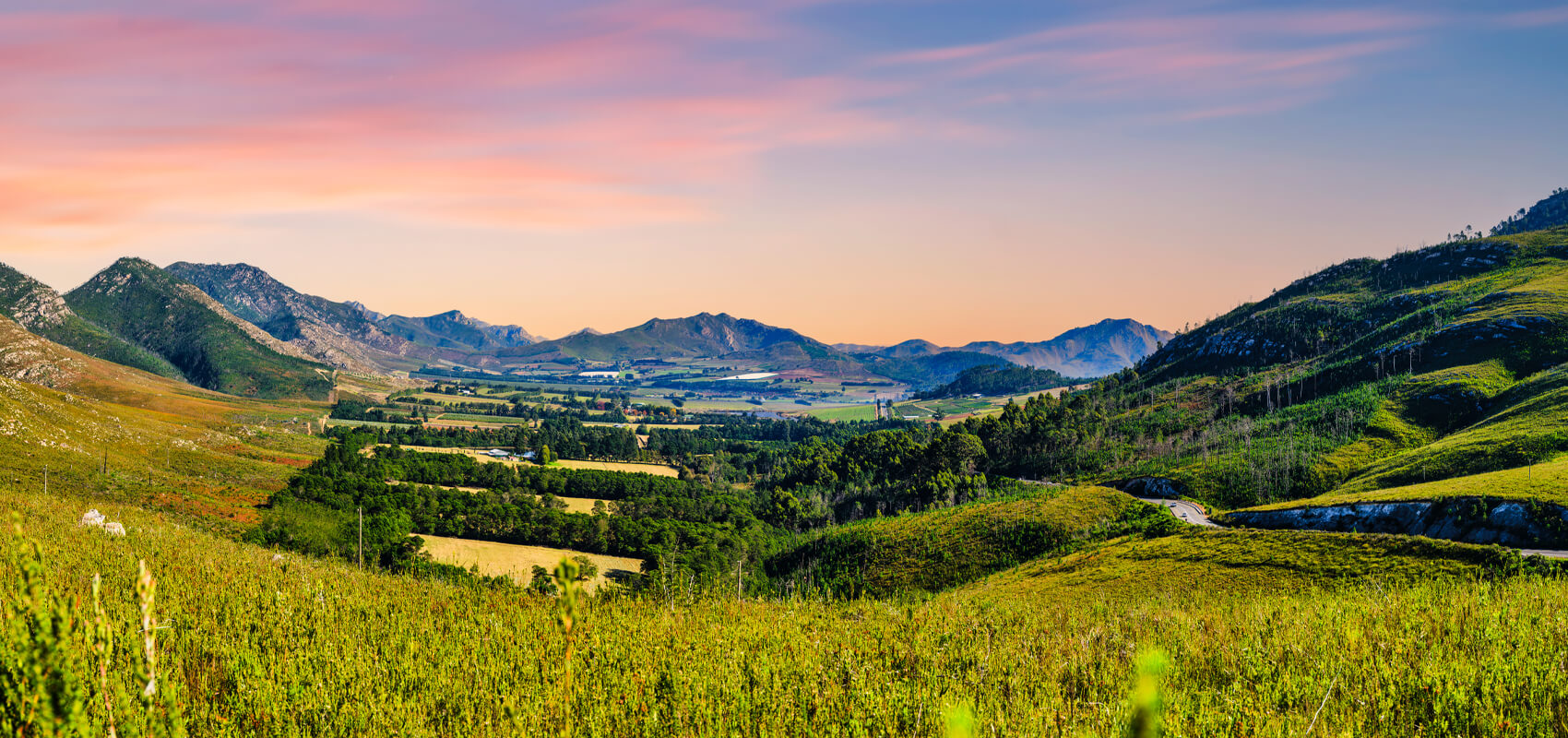 Scenic views of the Outeniqua Mountains near George, a highlight of the Garden Route.
Scenic views of the Outeniqua Mountains near George, a highlight of the Garden Route.
While George itself is more of a working town than a coastal village, it boasts several notable attractions. Nature lovers should not miss the Garden Route Botanical Garden, a serene sanctuary showcasing the diverse indigenous flora of the region, including fynbos and medicinal plants, complete with peaceful forest walks along winding streams. George is also renowned as one of South Africa’s premier golfing destinations, home to world-class courses like the famous Fancourt Golf Estate. For a fascinating look into the past, the Outeniqua Transport Museum houses an impressive collection of vintage steam trains and classic cars.
From George, you have easy access to nearby gems like the picturesque surfing cove of Victoria Bay and scenic drives over the Outeniqua Mountains – choose between the paved modern Outeniqua Pass or the winding, historic (mostly gravel) Seven Passes Road for a journey back in time.
Tips for Visiting George & Surrounds:
- Botanical Garden: A tranquil escape showcasing local fynbos and forest ecosystems. Allow time for a peaceful stroll. Link: Garden Route Botanical Garden
- Golf: A top destination for golfers. Book tee times well in advance, especially for championship courses. Link: Fancourt Golf
- Transport Museum: Engaging for families and anyone interested in railway history. Link: Outeniqua Transport Museum
- Victoria Bay: A beautiful small bay popular with surfers and beachgoers; can get busy.
- Mountain Passes: The Outeniqua Pass offers accessible scenic views. The Seven Passes Road is a longer, slower, mostly gravel adventure requiring careful driving.
- Hiking/Biking: Explore numerous trails in the surrounding mountains. Link: George Trails
- Base Location: George’s central location and airport make it a convenient base for exploring the mid-Garden Route and Klein Karoo. Link: George Tourism
2a. Hidden Gem: Herold Wines Mountain Retreat
While exploring the magnificent Outeniqua Mountains near George, consider a detour off the beaten path to discover a true hidden gem: Herold Wines. Accessed via the scenic and historic Montagu Pass, this boutique wine farm is nestled high on the fynbos-clad slopes of Cradock Peak, surrounded on three sides by the tranquil Outeniqua Nature Reserve.
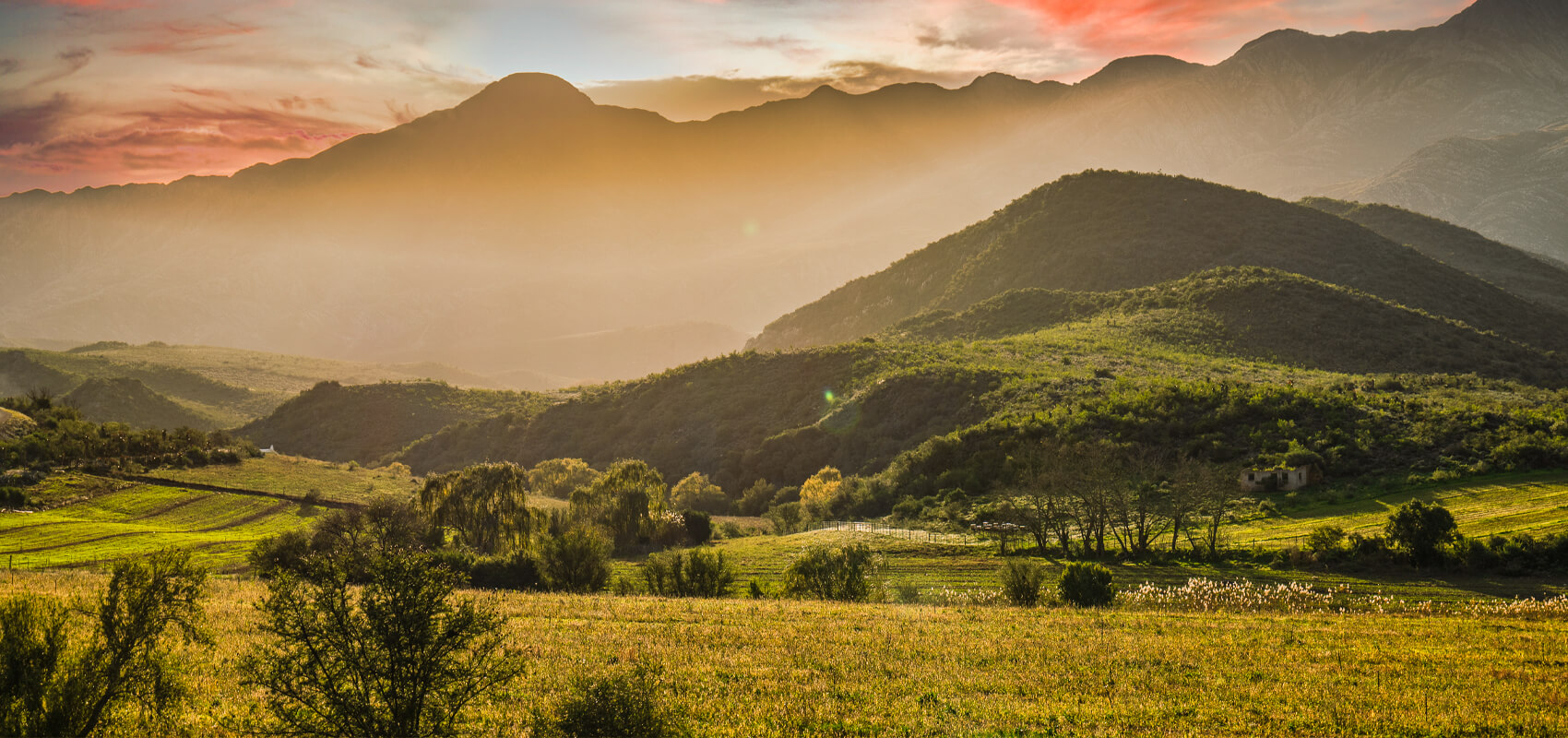 Herold Wines: A boutique winery offering stunning landscapes near George, South Africa.
Herold Wines: A boutique winery offering stunning landscapes near George, South Africa.
This isn’t your typical large-scale wine estate; Herold Wines offers a charming, village-like atmosphere and a peaceful retreat from the main tourist route. Its unique high-altitude vineyards (some of the highest in South Africa) experience cool mountain mists and crisp winters, resulting in a long growing season perfect for producing distinctive cool-climate wines, with Pinot Noir being a notable speciality. Enjoy relaxed, intimate wine tastings often hosted by the owners themselves in the working cellar, perhaps paired with a delicious cheese platter or pizza amidst views of the vines stretching towards the mountain backdrop.
Tips for Visiting Herold Wines:
- Wine Tasting: Experience unique high-altitude wines, especially their Pinot Noir. Tastings are relaxed and often conducted in the cellar.
- Food: Light lunches, cheese platters, and weekend pizzas are typically available, perfect for pairing with the wines. Check availability beforehand.
- Atmosphere: Expect a peaceful, family-run farm setting offering homely hospitality – ideal for escaping the crowds.
- Opening Hours: Generally open Mon-Sat 10:00 – 16:00 (closed Sundays & specific public holidays). It’s always wise to call ahead or check their website if making a special trip. Link: Herold Wines Website
- Activities: Enjoy farm walks, explore fynbos paths, access hiking trails into the adjacent nature reserve, or cool off in river swimming pools on the property.
- Accommodation: Self-catering farm cottages are available for a longer, peaceful stay.
3. Oudtshoorn: Ostriches, Caves & Karoo Charm
Leaving the coastal forests behind, our journey takes a fascinating detour inland (typically via George) into the unique landscape of the Klein Karoo to visit Oudtshoorn. Nestled between the imposing Swartberg and Outeniqua mountain ranges, this charming town is world-famous as the “Ostrich Capital,” a legacy from the booming feather trade over a century ago.
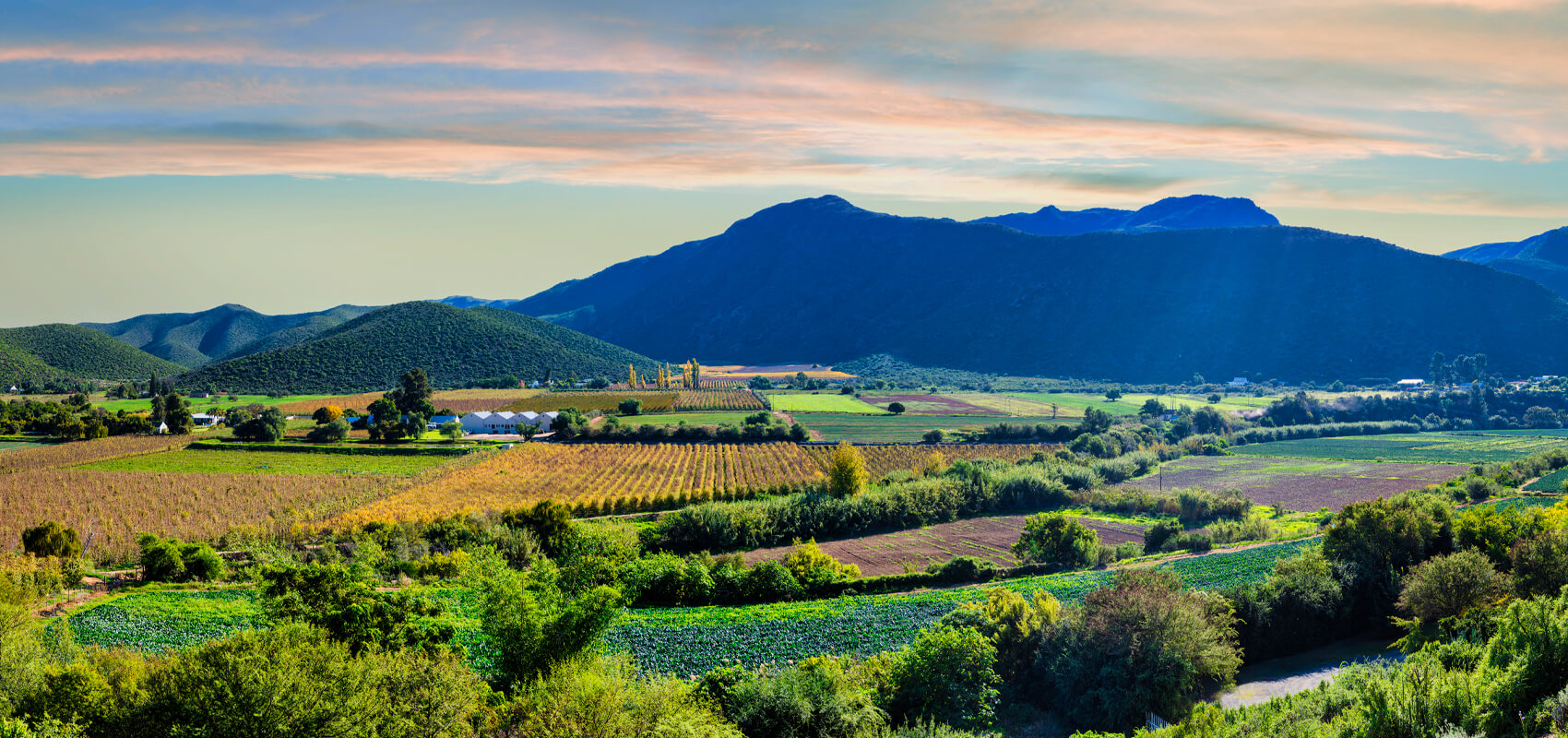 Scenic views of Oudtshoorn’s dramatic mountains and fertile farms in South Africa.
Scenic views of Oudtshoorn’s dramatic mountains and fertile farms in South Africa.
The undisputed subterranean star here is the Cango Caves, one of South Africa’s oldest and most popular natural wonders. This vast, 20-million-year-old limestone cave system features enormous caverns adorned with spectacular stalactite and stalagmite formations. Guided tours (available in multiple languages) lead you through this underground marvel, with options ranging from the relatively easy Heritage Tour exploring the main halls to a challenging Adventure Tour for the nimble, involving crawls through narrow passages.
No trip to Oudtshoorn is complete without encountering its namesake bird. Visiting an Ostrich Show Farm offers a chance to learn about these magnificent flightless birds, see the incubators, meet chicks (in season), and even get the unique opportunity to feed an ostrich by hand. Guided tours provide fascinating insights into the farming process and the history of the feather industry.
Tips for Visiting Oudtshoorn:
- Detour Planning: Remember, Oudtshoorn is inland from the main Garden Route N2. Visiting typically requires adding at least one full day and an overnight stay to your itinerary.
- Cango Caves: Booking tours (Heritage or Adventure) in advance is strongly recommended, especially during peak season, as numbers are limited. Check requirements for the Adventure Tour (it’s not suitable for everyone). Link: Cango Caves Official Website
- Ostrich Farms: Several show farms offer tours. Choose a reputable one for an informative and ethical experience. Links: Highgate Ostrich Show Farm | Cango Ostrich Show Farm
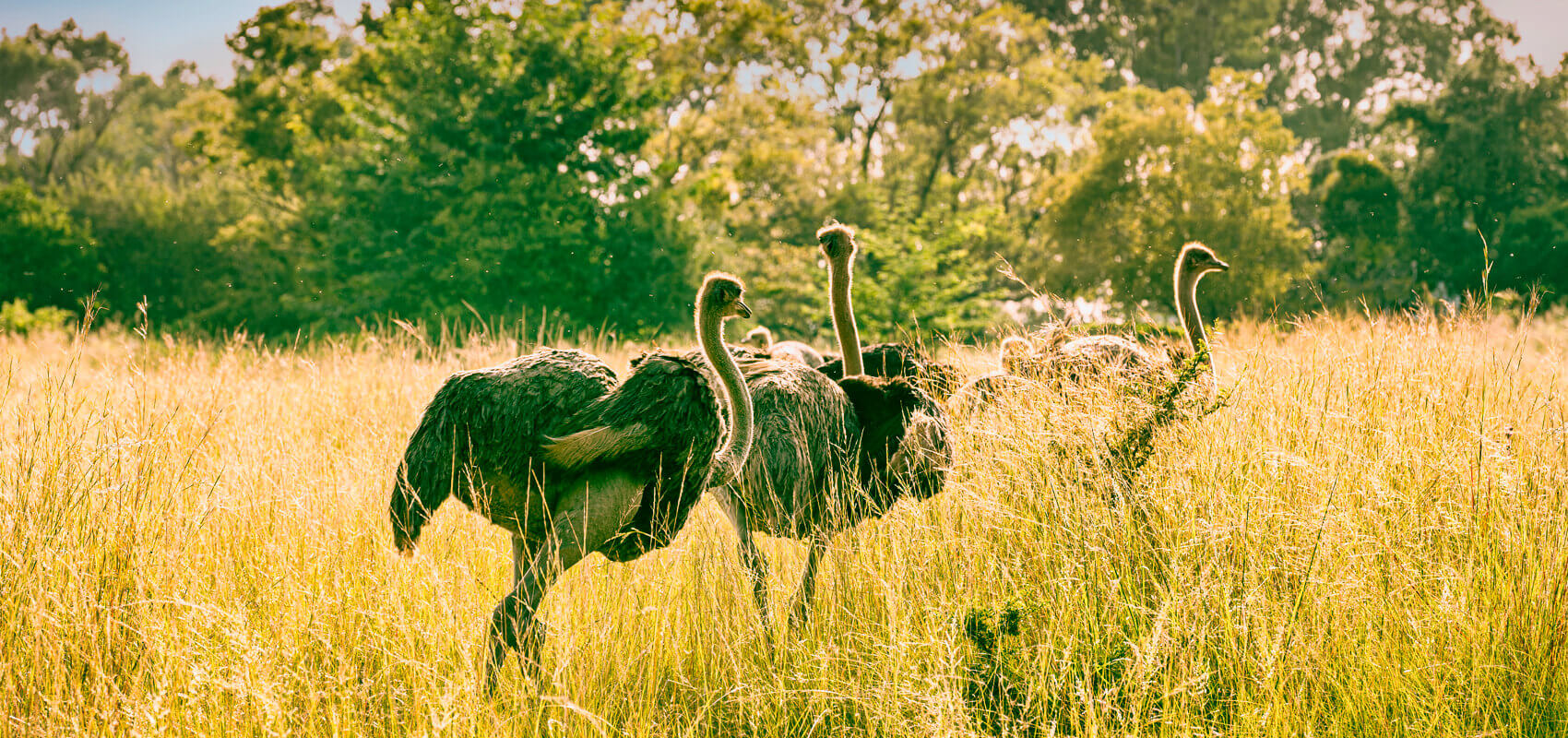 Scenic views of ostriches grazing near Oudtshoorn along South Africa’s Garden Route.
Scenic views of ostriches grazing near Oudtshoorn along South Africa’s Garden Route.
- Other Wildlife: Consider an early morning Meerkat encounter (booking essential) or a visit to the Cango Wildlife Ranch. Link: Cango Wildlife Ranch
- Scenic Drives: Oudtshoorn is the gateway to the stunning Swartberg Pass (gravel - check conditions) and Meiringspoort (paved) mountain passes.
- General Info: For more accommodation and activity options. Link: Oudtshoorn Tourism
4. Hidden Gem: Kaaimans River Viewpoint & Crossing
As you continue east from George towards Wilderness on the N2 highway, prepare for an “indescribably beautiful” stretch of road. A key feature, often glimpsed quickly while driving, is the crossing of the Kaaimans River. While there are formal viewpoints like Dolphin Point further along, the pull-offs around the Kaaimans River bridge itself offer breathtaking scenery that can feel like a hidden gem if you take the time to stop safely.
Look down into the steep, lush gorge where the river meets the ocean waters. The scene is often framed by the iconic (currently disused) old railway bridge spanning the river mouth. It’s a picturesque snapshot of the Garden Route’s dramatic meeting of mountains, forest, river, and sea. Beyond just the view, the river mouth below is a hub for adventure, inviting exploration by water – consider driving down to try canoeing or kayaking upstream towards waterfalls.
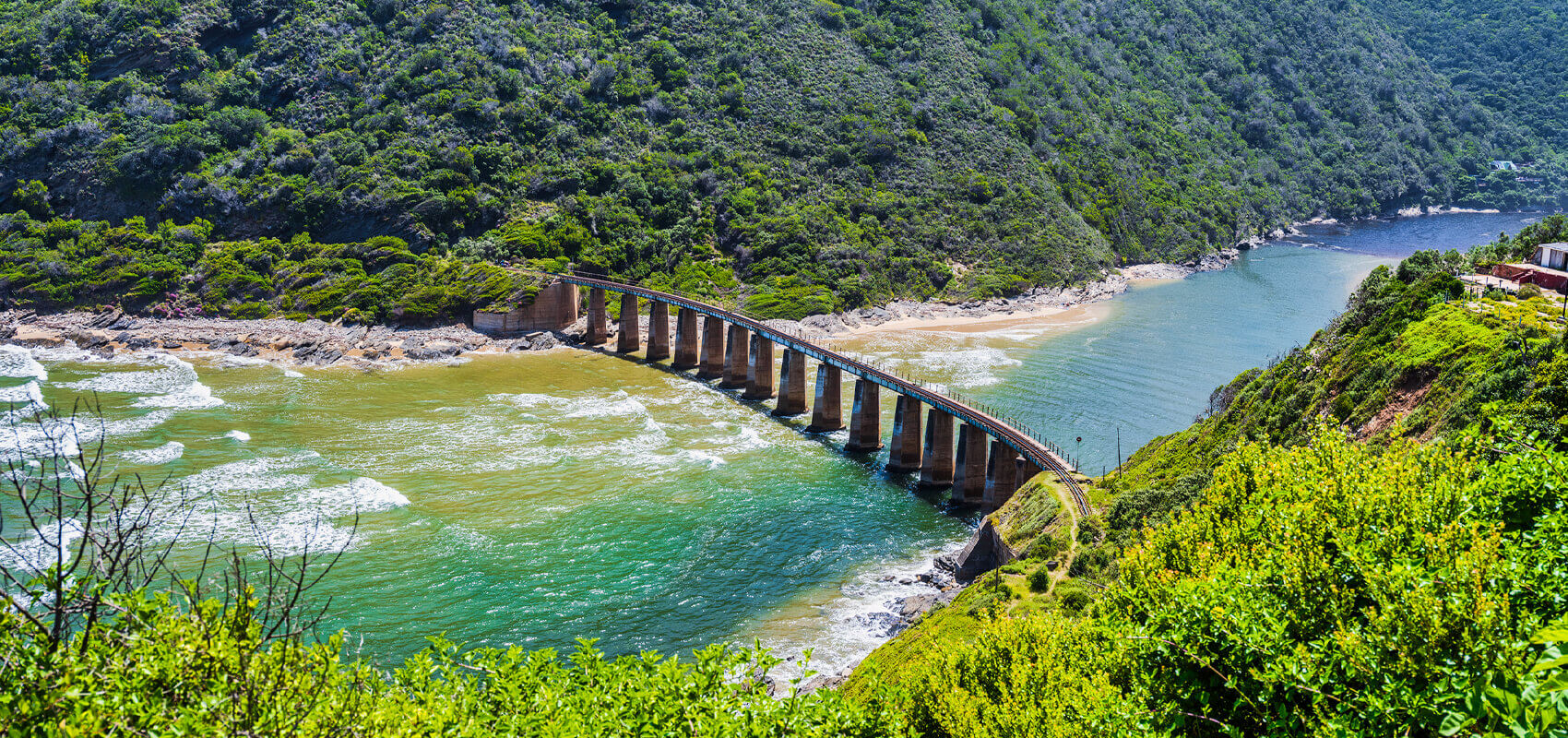 Kaaimans River bridge surrounded by lush greenery in George, South Africa’s Garden Route
Kaaimans River bridge surrounded by lush greenery in George, South Africa’s Garden Route
Tips for Visiting Kaaimans River:
- Location: Viewpoints are informal pull-offs along the N2 highway between George and Wilderness, near the main river bridge. Use extreme caution when stopping and rejoining traffic.
- The View: Offers spectacular perspectives of the river mouth, gorge, forests, and the historic railway bridge.
- River Activities: Kayak and SUP (Stand-Up Paddleboard) hire is available down at the river mouth area (Kaaimans Adventures), allowing you to paddle upstream into the gorge towards waterfalls. Kloofing (canyoning) tours also operate in the gorge for the more adventurous. Link: Kaaimans Adventures
- Railway Bridge: Admire the bridge as a piece of history; the famous Outeniqua Choo Tjoe steam train no longer runs on this line.
- Safety: Be very careful when stopping at highway viewpoints due to fast-moving traffic. Ensure your vehicle is parked completely off the road. Accessing the river usually requires driving down to the dedicated activity area near the river mouth.
5. Wilderness: Lakes, Forests & Tranquil Charm
Nestled between the Kaaimans River and the Goukamma Nature Reserve, the charming seaside village of Wilderness offers a distinct change of pace and a true immersion in nature. Known for its tranquil atmosphere, it’s cherished by nature lovers for its diverse landscapes, including pristine beaches stretching for kilometres, dense indigenous forests, and a unique network of serene rivers and interconnected lakes (vleis).
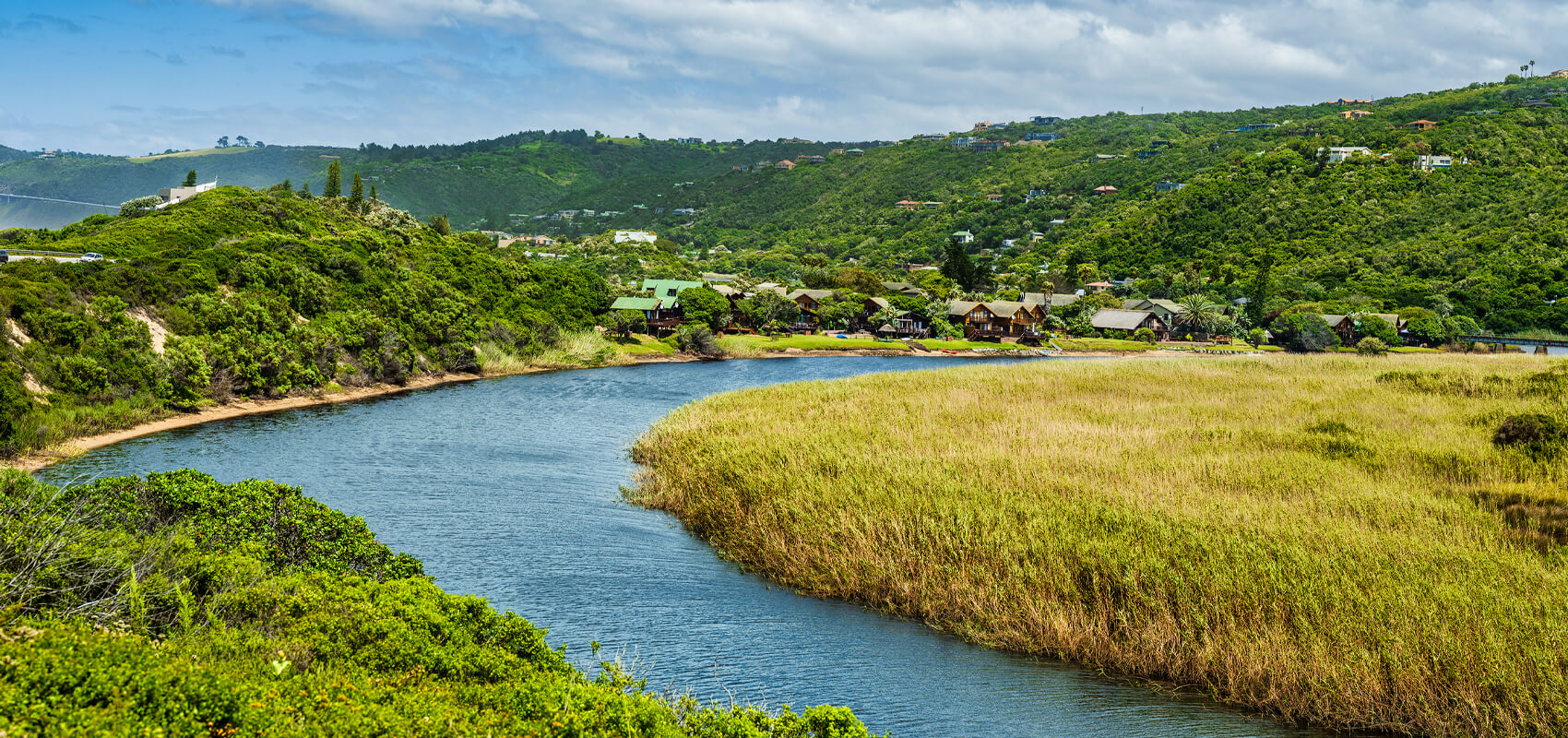 Tranquil river surrounded by nature in Wilderness, a must-see on the Garden Route.
Tranquil river surrounded by nature in Wilderness, a must-see on the Garden Route.
The heart of this area is the Wilderness Section of the Garden Route National Park, a protected sanctuary encompassing the Touw River estuary, the Serpentine River, and the chain of lakes like Langvlei and Rondevlei – recognized as a Ramsar Wetland of International Importance. Exploring this watery wonderland by canoe or kayak is a quintessential Wilderness experience; paddle gently up the Touw River through forested gorges towards hidden waterfalls, or explore the Serpentine’s meandering path through reed beds rich with birdlife. Numerous hiking trails, like the popular Kingfisher routes, wind through the forests, offering close encounters with nature and leading to beautiful cascades. For breathtaking perspectives, drive up to the Map of Africa viewpoint or consider a tandem paragliding flight for an unforgettable aerial view.
Tips for Visiting Wilderness:
- Explore the National Park: Spend time in the Wilderness Section of the Garden Route. Park conservation fees apply for accessing areas like the Ebb & Flow Rest Camp and certain trailheads. Link: SANParks - Garden Route
- Paddle the Waters: Hiring a canoe or kayak is highly recommended. Rentals are available at the Ebb & Flow Rest Camp or from local operators. Link: Eden Adventures (Offers canoe hire & other activities)
- Hiking Trails: Choose from several beautiful trails, such as the Kingfisher routes, often starting near Ebb & Flow. Obtain maps and check conditions.
- Map of Africa: Don’t miss this unique geographical viewpoint offering stunning panoramas.
- Paragliding: Conditions are often favourable for tandem paragliding flights, providing incredible views over the coastline and lakes. Link: Cloudbase Paragliding
- Birdwatching: A paradise for birders, especially around the lakes and rivers. Visit the Malachite and Rondevlei bird hides.
- General Info: Link: Wilderness info
6. Sedgefield: The Slow Town Hidden Gem
Nestled between Wilderness and Knysna, Sedgefield offers a delightful change of pace. Often bypassed by travellers rushing between the major hubs, this unassuming village proudly holds the title of Africa’s first accredited “Cittaslow” or “Slow Town,” reflecting its commitment to a relaxed lifestyle and connection with nature. Surrounded by tranquil lakes, rivers, and pristine beaches, Sedgefield is a true hidden gem for those seeking peace and authentic local experiences.
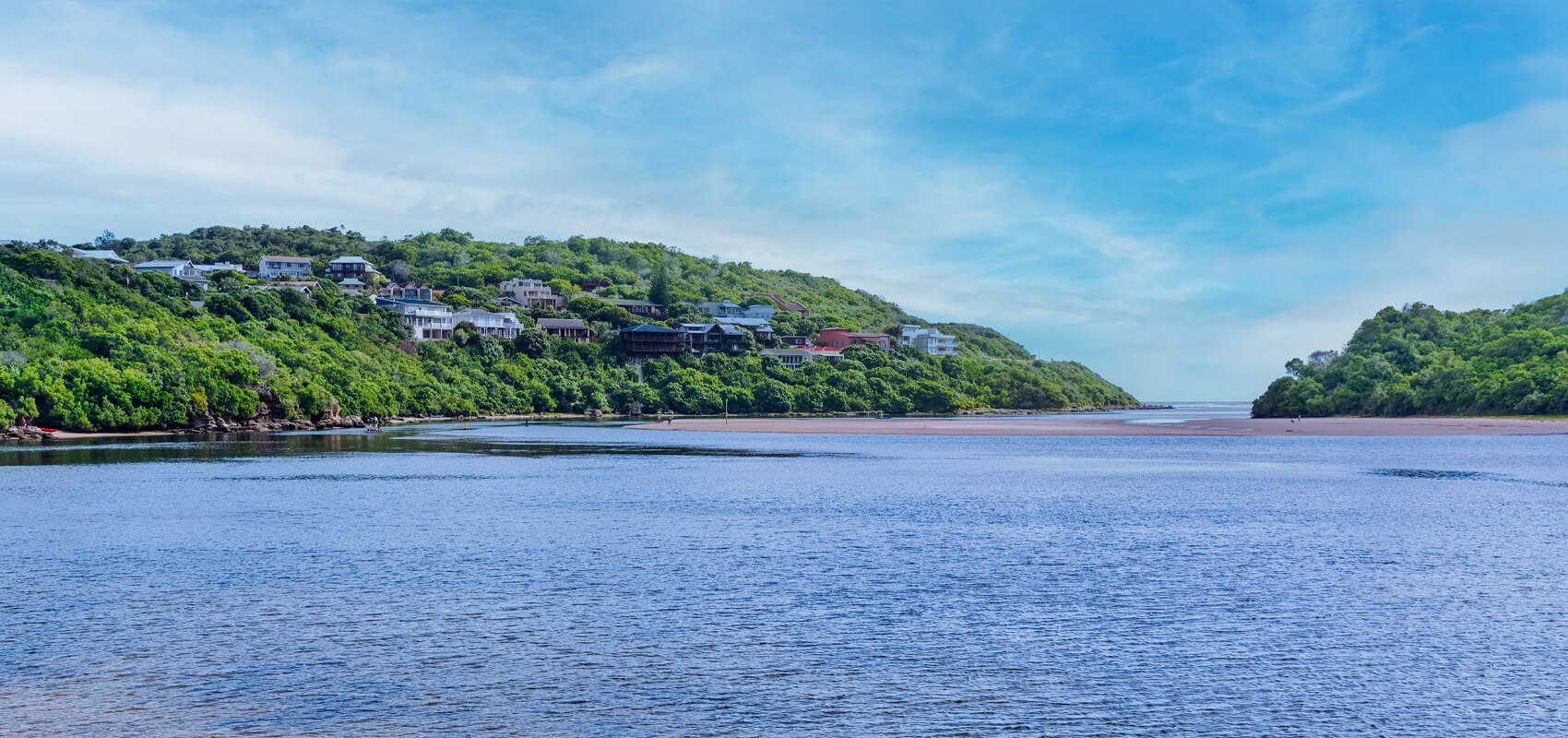 Stunning Sedgefield lagoon nestled along South Africa’s picturesque Garden Route.
Stunning Sedgefield lagoon nestled along South Africa’s picturesque Garden Route.
Life here revolves around the water. We personally loved the vast Swartvlei Lagoon system which is perfect for leisurely kayaking, stand-up paddleboarding (SUP), fishing, or simply watching the abundant birdlife. Beautiful, often uncrowded beaches like Myoli and Cola stretch for kilometres, ideal for long walks or relaxing swims. Don’t miss Gericke’s Point, a fascinating rocky headland perfect for exploring intricate rock pools teeming with life at low tide. For a taste of local life, the vibrant Wild Oats Community Farmers’ Market on Saturday mornings is an absolute must-visit, showcasing the best local produce, artisanal foods, and crafts in a festive atmosphere. Nearby, the Goukamma Nature Reserve offers lovely hiking trails through coastal fynbos and forests.
Tips for Visiting Sedgefield:
- Wild Oats Market: A highlight, held every Saturday morning (summer 07:30-12:00, winter 08:00-12:00). Arrive early for the best selection and atmosphere. Link: Wild Oats Market
- Lagoon Fun: Hire a kayak or SUP to explore the calm waters of the Swartvlei Lagoon.
- Beach Time: Enjoy the relatively uncrowded stretches of sand like Myoli Beach (popular for surfing/kitesurfing) or Cola Beach.
- Gericke’s Point: Check the tide schedule online before visiting – low tide is essential for safely exploring the rock pools and caves.
- Goukamma Nature Reserve: Explore hiking trails in this CapeNature reserve protecting the estuary and dune ecosystems. Link: Goukamma Nature Reserve
- Views: Drive up to the Cloud 9 Lookout point for stunning panoramic views over the lagoon and ocean – a great sunset spot and paragliding launch site.
- Slow Down: Embrace the “Slow Town” philosophy – relax, explore the Mosaic Art Route around town, and enjoy the unhurried pace. Link: Sedgefield Tourism
7. Knysna: Jewel of the Garden Route
Often hailed as the “Jewel of the Garden Route,” Knysna is a captivating town built around the shores of a magnificent tidal lagoon, guarded from the Indian Ocean by two dramatic sandstone cliffs known as The Heads. This picturesque setting, combined with a bustling atmosphere, makes Knysna a favourite stop for many travellers.
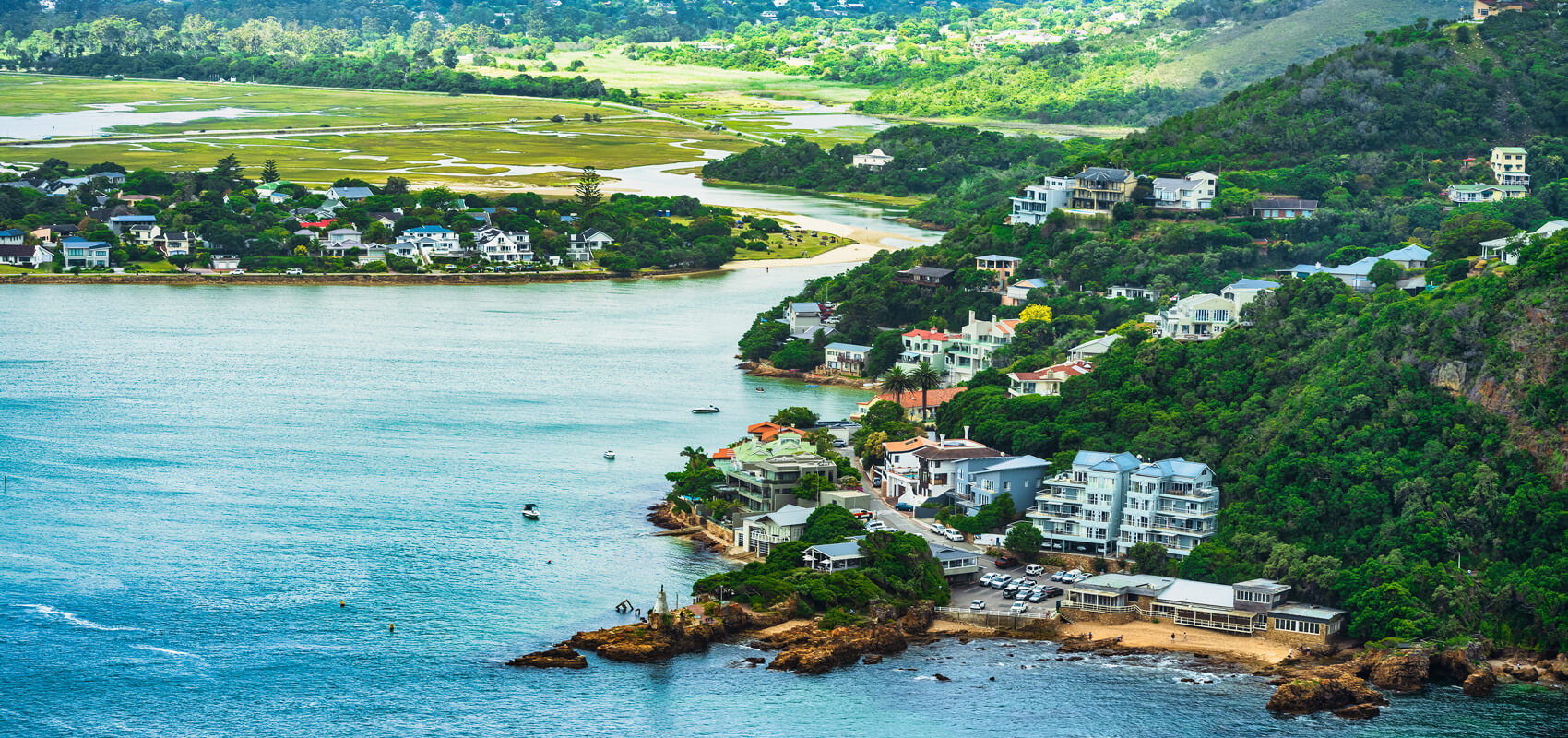 Knysna Heads offering panoramic coastal vistas along South Africa’s Garden Route
Knysna Heads offering panoramic coastal vistas along South Africa’s Garden Route
The lively Knysna Waterfront is a central hub, offering a delightful mix of restaurants, cafes, boutiques, and galleries overlooking the marina – it’s the perfect place to soak up the atmosphere or book a lagoon adventure. The expansive Knysna Lagoon itself is a playground for water activities; consider hiring kayaks or stand-up paddleboards to explore its calm waters, or take one of the many boat cruises offering sunset views, oyster tastings, or trips towards The Heads.
A signature Knysna experience is visiting the Featherbed Nature Reserve, our personal favorite, a private reserve situated on the less accessible Western Head. Reached via a scenic ferry trip across the lagoon, the guided tour typically involves a 4x4 drive to the top of the headland followed by an informative nature walk along cliff-top paths, offering spectacular views back towards the lagoon entrance and often including lunch served under the milkwood trees. While the Heads are stunning, don’t forget the ancient Knysna Forests surrounding the town, offering tranquil hiking trails amongst giant trees. And of course, Knysna is synonymous with delicious oysters, cultivated right here in the lagoon.
Tips for Visiting Knysna:
- Lagoon Exploration: A boat cruise is highly recommended for experiencing the lagoon and seeing The Heads from the water. Kayak or SUP rentals also offer a great way to explore independently.
- Featherbed Nature Reserve: This popular eco-experience requires booking in advance for the ferry and guided tour (options with or without lunch available). Link: Featherbed Co.
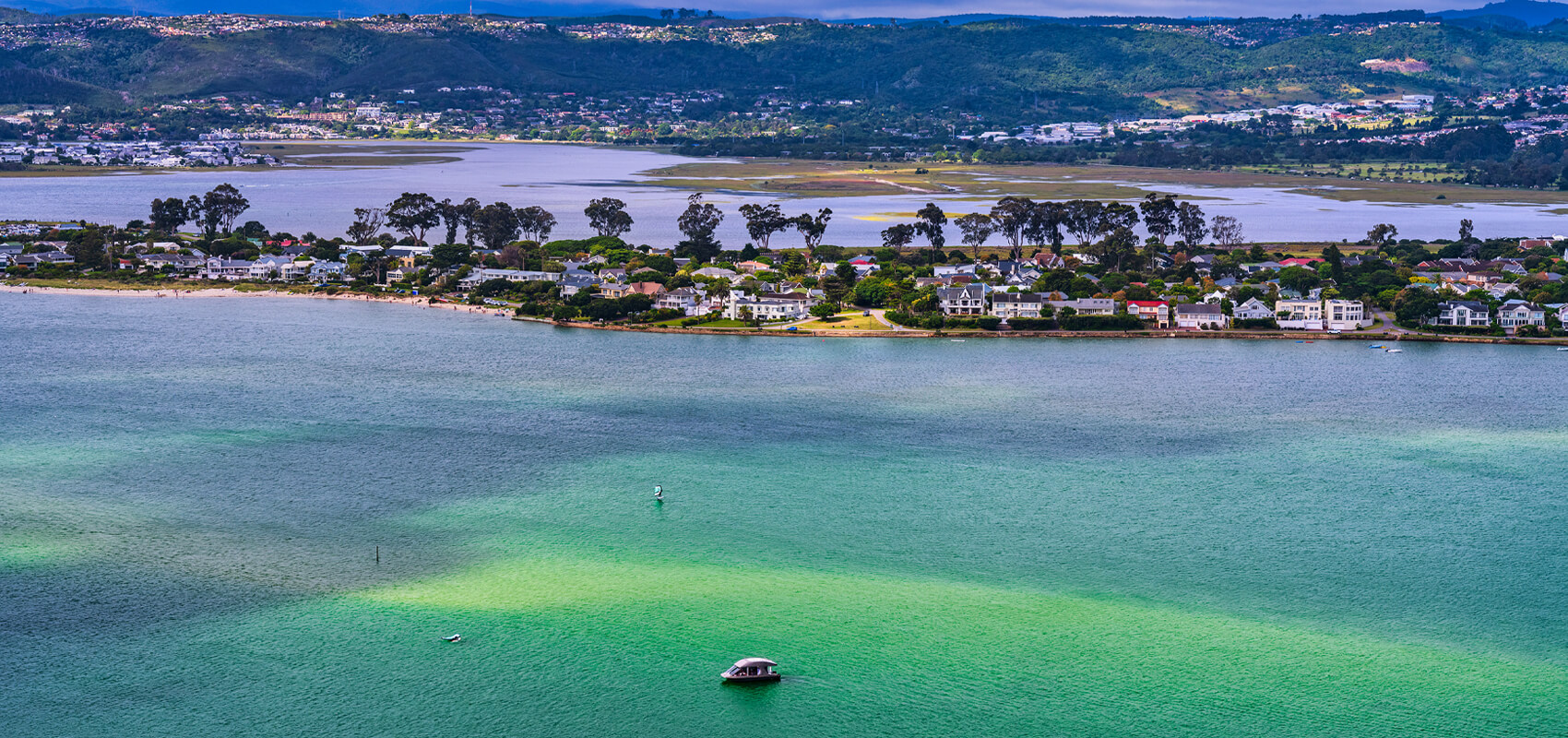 Leisure Island’s turquoise lagoon offering calm waters and scenic beauty in Knysna.
Leisure Island’s turquoise lagoon offering calm waters and scenic beauty in Knysna.
- East Head Viewpoint: For easily accessible, spectacular views of the lagoon mouth and the Western Head, drive up to the viewpoint on the Eastern Head.
- Knysna Waterfront: Ideal spot for dining (especially oysters!), shopping, and arranging lagoon excursions.
- Forest Walks: Explore trails in the nearby Knysna forest section of the Garden Route National Park, such as the “Circles in the Forest” trail. Link: SANParks - Garden Route
- Oysters: Be sure to sample the local delicacy! Numerous restaurants specialize in fresh Knysna oysters. The Knysna Oyster Festival takes place annually in July.
- Elephant Encounters: For an ethical experience interacting with rescued elephants, visit the nearby Knysna Elephant Park. Link: Knysna Elephant Park
- General Info: Link: Visit Knysna (Official Tourism Site)
8. Plettenberg Bay: Beaches, Hikes & Wildlife Wonders
Affectionately known as “Plett,” Plettenberg Bay is a perennially popular destination on the Garden Route, famed for its expansive golden beaches, vibrant atmosphere (especially in summer), and exceptional access to marine wildlife and nature reserves. It perfectly blends sophisticated holiday town amenities with breathtaking natural beauty.
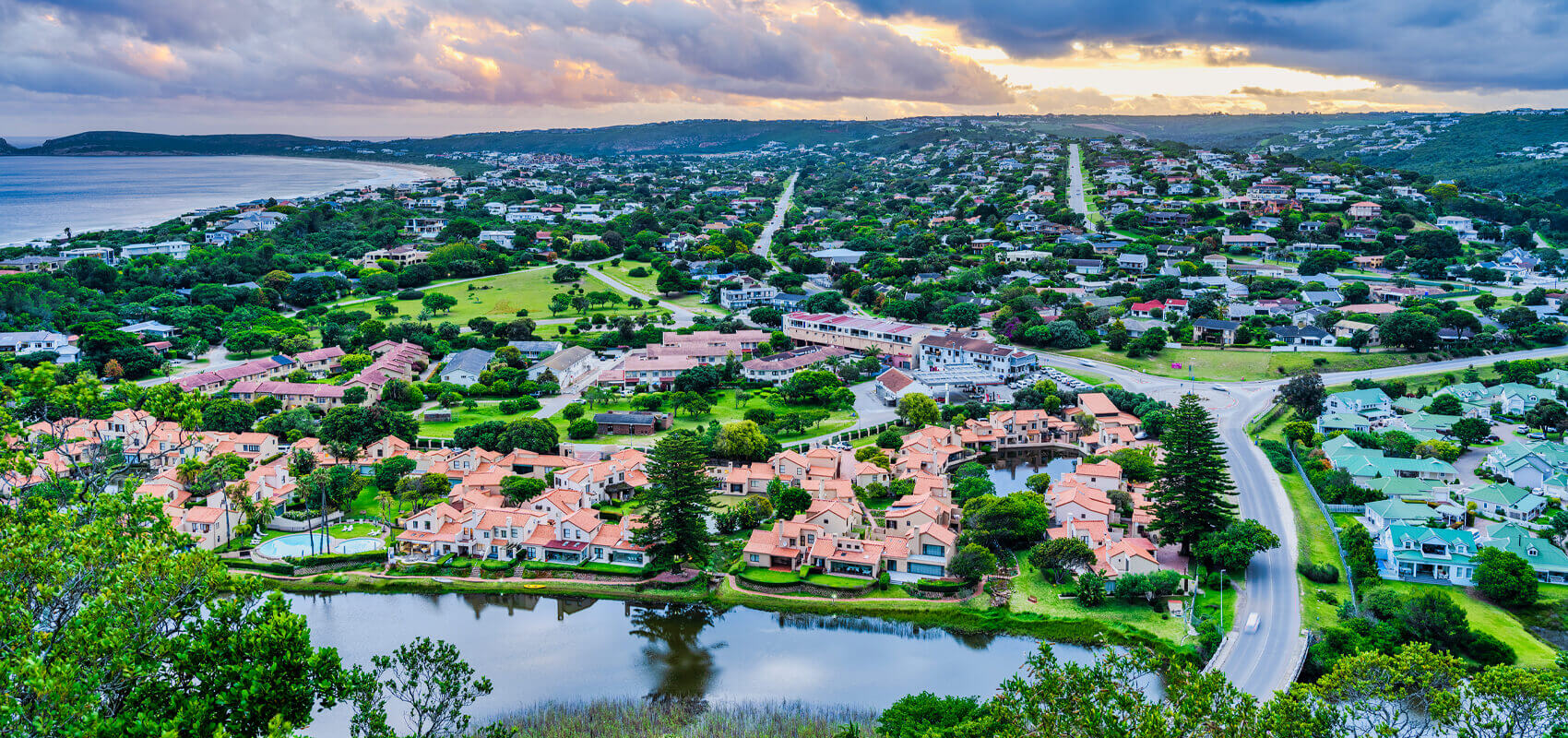 Plettenberg Bay town nestled amidst rolling hills on the iconic Garden Route.
Plettenberg Bay town nestled amidst rolling hills on the iconic Garden Route.
Plett offers several stunning beaches, many with Blue Flag status, like the accessible Central Beach (hub for boat tours) and the beautiful sweep of Robberg Beach. However, the absolute must-do here for nature lovers and hikers is exploring the Robberg Nature Reserve. This peninsula, a World Heritage Site, juts dramatically into the ocean, offering spectacular coastal scenery, fascinating Stone Age archaeological history, and fantastic hiking trails ranging from easy strolls to a challenging circuit around the point. Keep an eye out for the large Cape fur seal colony residing here, and during whale season (June-Nov), it’s a prime spot for watching whales and dolphins from the cliffs.
The bay is also a hotspot for marine activities. Numerous operators offer boat trips specifically for whale and dolphin watching, or even guided excursions to snorkel or swim with the playful seals near Robberg. Just a short drive away in The Crags area, you’ll also find renowned wildlife sanctuaries like Birds of Eden and Monkeyland, offering immersive experiences.
Tips for Visiting Plettenberg Bay:
- Robberg Nature Reserve: Allow several hours for hiking; choose a trail matching your fitness (the full Point Circuit is strenuous but rewarding). Wear sturdy shoes, carry water and sun protection. Look out for seals, dolphins, and whales (in season). An entrance fee applies. Link: Robberg Nature Reserve
- Beaches: Enjoy swimming, sunbathing, or surfing at Central Beach, Lookout Beach, or Robberg Beach.
- Marine Tours: Book boat-based whale/dolphin watching or seal swimming tours in advance, especially during peak season (June-Nov for whales). Link: Ocean Blue Adventures
- Wildlife Sanctuaries: Set aside time to visit Birds of Eden (free-flight aviary) and Monkeyland (free-roaming primates) in the nearby Crags area. Combo tickets are available. Link: SAASA Sanctuaries
- Keurbooms River: Explore the nearby Keurbooms River Nature Reserve for boating, paddling, and forest walks.
- Peak Season: Plett gets very busy during South African summer holidays (December/January); book accommodation and activities well in advance if travelling then.
- General Info: Link: Plett Tourism (Official Tourism Site)
8a. Keurbooms River: Nature & River Activities
Just a 10-minute drive east from Plett brings you to the beautiful Keurbooms River and the Keurbooms River Nature Reserve. This area offers a wonderful contrast to the ocean beaches, inviting exploration of its spectacular wooded river gorge, best accessed by boat or canoe. Consider taking a relaxing ferry trip upstream, winding through the gorge surrounded by indigenous forest, perhaps stopping at a secluded river beach. Alternatively, hire kayaks or canoes to paddle at your own pace, keeping an eye out for the area’s rich birdlife, including the colourful Knysna Turaco (Loerie) and various kingfishers.
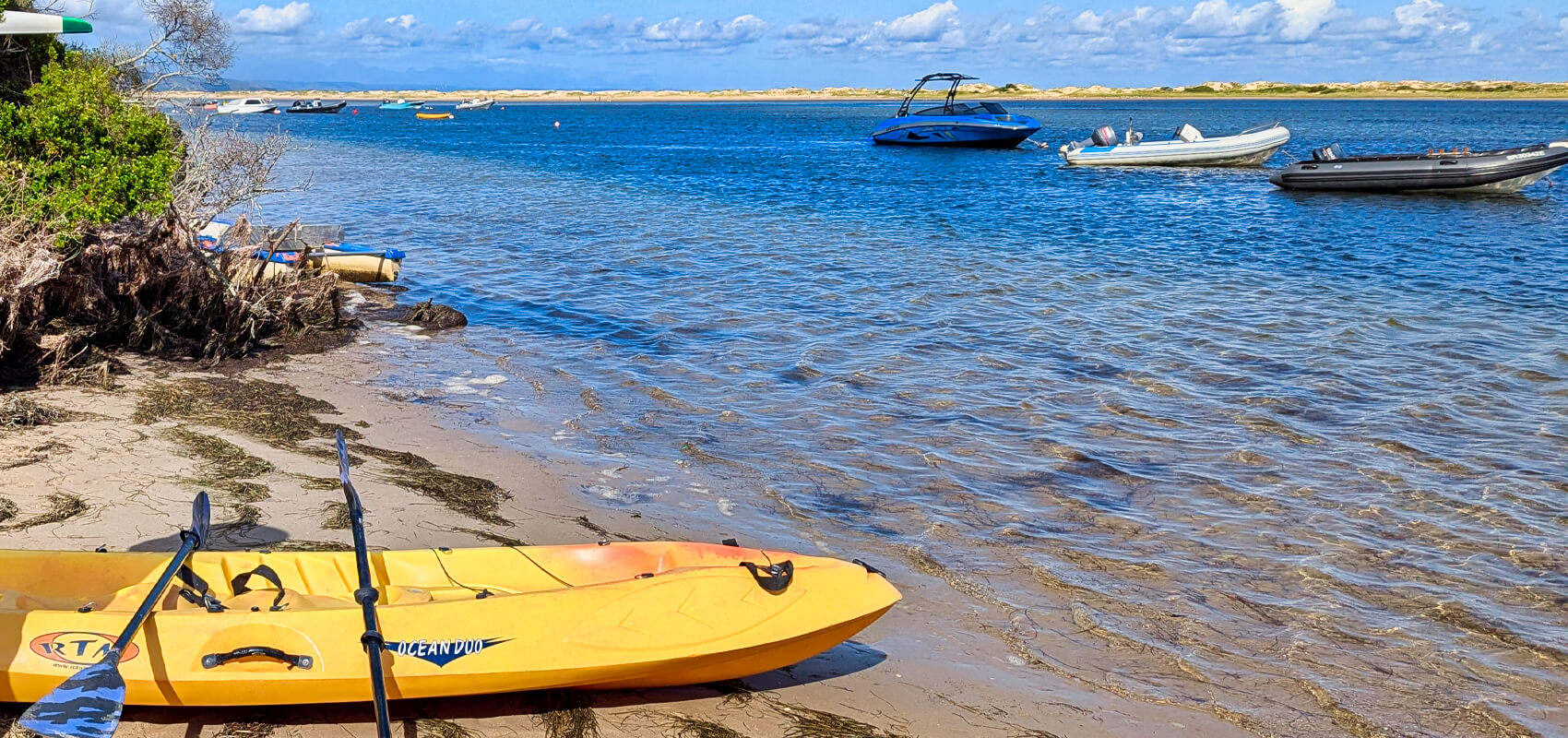 Picturesque Keurbooms River offering kayaking fun amidst nature in South Africa.
Picturesque Keurbooms River offering kayaking fun amidst nature in South Africa.
Tips for Visiting Keurbooms River:
- River Ferries: Guided ferry trips travel about 5km upriver into the reserve, often including a stop at a beach area. Booking is advisable. Link: Keurbooms River Ferries
- Kayak/Canoe Hire: Rent kayaks or canoes near the river mouth for independent exploration.
- Reserve Info: The reserve is managed by CapeNature. Link: Keurbooms River Nature Reserve
8b. Nature’s Valley: Tranquil Village Escape
Further east, nestled deep within the Tsitsikamma forest section of the Garden Route National Park, lies the incredibly picturesque coastal village of Nature’s Valley. This secluded hamlet offers a truly tranquil escape, boasting a pristine sandy beach fringed by indigenous forest and a calm lagoon fed by the Groot River, perfect for swimming and paddling. It’s also famously the end point of the gruelling multi-day Otter Trail hike. If you’re seeking peace and quiet away from the main tourist hubs, Nature’s Valley is an idyllic stop.
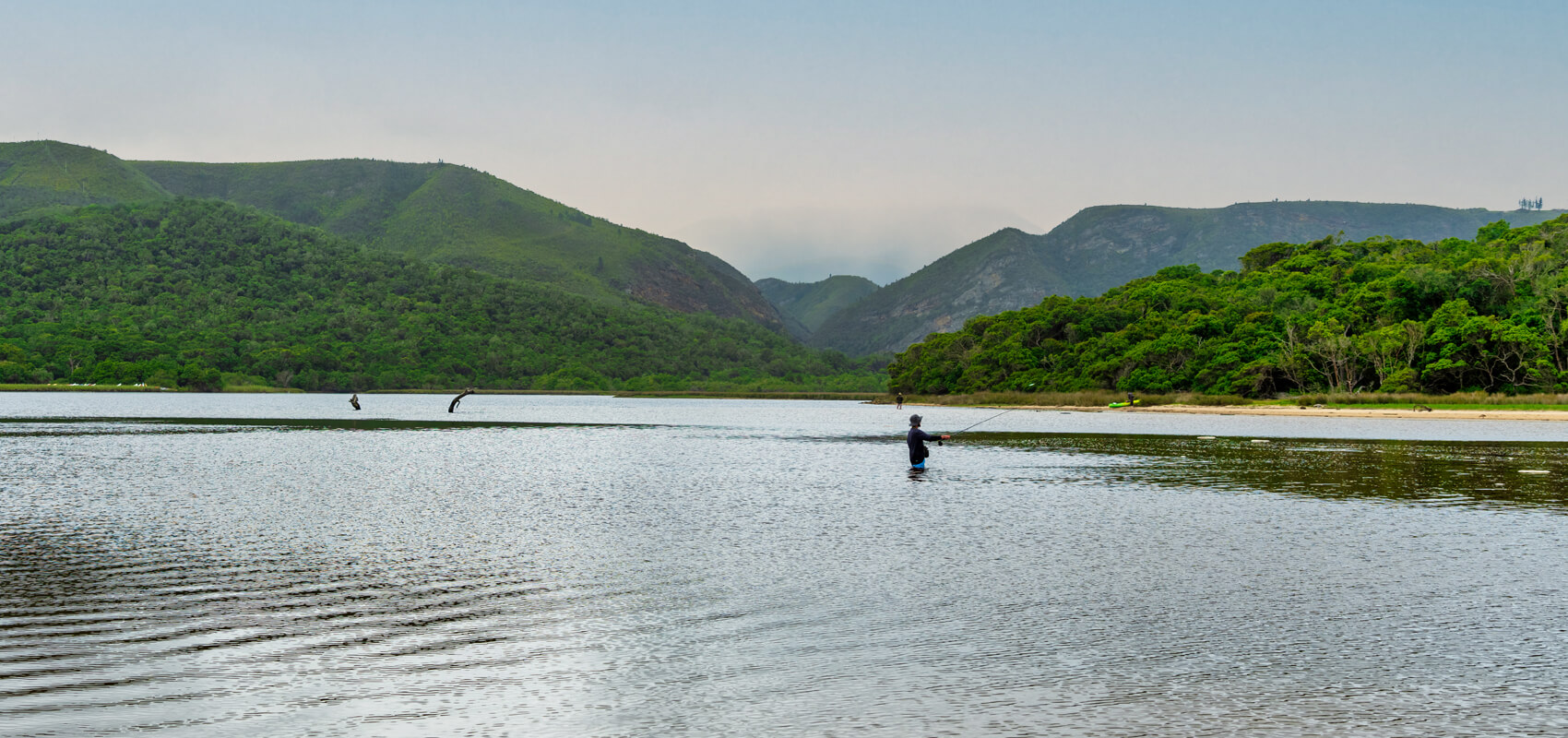 Picturesque fly-fishing experience by the calm waters of Nature’s Valley lagoon.
Picturesque fly-fishing experience by the calm waters of Nature’s Valley lagoon.
Tips for Visiting Nature’s Valley:
- Beach & Lagoon: Enjoy the beautiful beach and safe swimming/paddling in the Groot River lagoon.
- Hiking: Access various forest trails within the surrounding Tsitsikamma National Park.
- Amenities: Be aware that shops and restaurants are very limited compared to Plett or Storms River Village.
8c. Tsitsikamma National Park: Coastal Drama & Forest Adventures
Continuing east brings you to the heart of the Tsitsikamma National Park, a breathtaking coastal haven where dramatic cliffs plunge into the churning Indian Ocean, ancient indigenous forests cloak deep gorges, and adventure awaits. The main focal point for visitors is the Storms River Mouth area. Here you can walk through the forest on boardwalks to the iconic Storms River Suspension Bridge, offering thrilling views over the river mouth below. This area is also the starting point for the famous Otter Trail and other shorter hikes, like the Waterfall Trail. For a unique perspective, consider kayaking or taking a lilo trip up the magnificent Storms River Gorge. Adventure activities like ziplining through the forest canopy are also popular nearby.
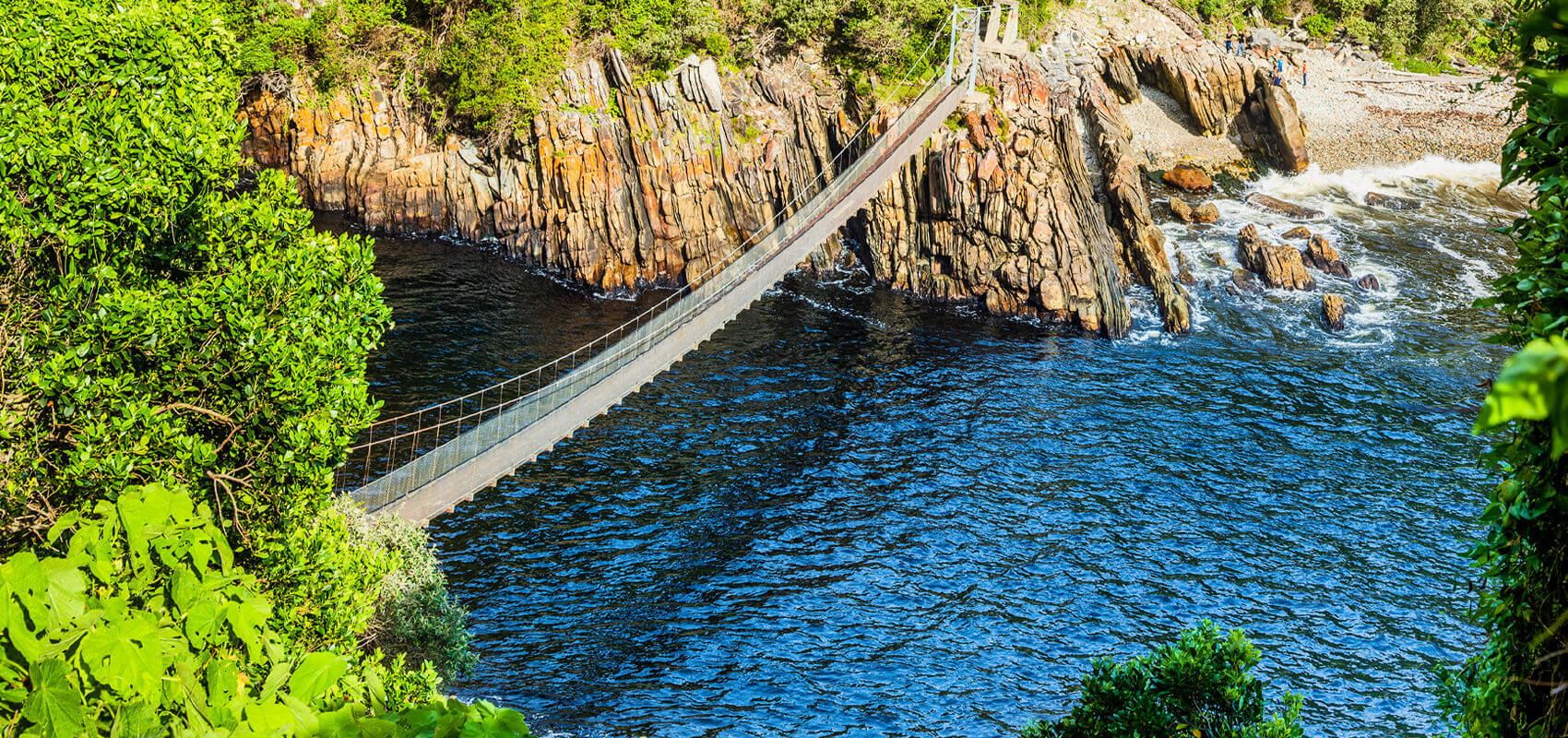 Scenic Storm River Bridge crossing the dramatic Tsitsikamma landscape in South Africa.
Scenic Storm River Bridge crossing the dramatic Tsitsikamma landscape in South Africa.
Tips for Visiting Tsitsikamma National Park:
- Storms River Mouth: This is the main visitor hub with accommodation, a restaurant, and activity starting points.
- Suspension Bridge Walk: An easy and incredibly scenic 1-hour return walk; a must-do.
- Water Activities: Explore the Storms River Gorge via kayak & lilo trips or blackwater tubing for unique views. Links: Untouched Adventures (Kayak/Lilo) | Blackwater Tubing
- Canopy Tours/Ziplining: Experience the forest from above with nearby zipline tours. Link: Tsitsikamma Canopy Tours
- Park Fees: Daily conservation fees are payable to enter the National Park (Storms River Mouth section).
8d. Bloukrans Bridge: The Ultimate Leap
Just a short drive (approx. 17 minutes) east from the Tsitsikamma National Park entrance, you’ll cross the impressive Bloukrans Bridge, spanning a deep river gorge. This bridge is world-famous for one main reason: it’s home to the highest commercial bridge bungee jump on the planet! For adrenaline junkies, leaping 216 meters from this architectural marvel is the ultimate thrill. If plunging towards the river below isn’t your cup of tea, you can still experience the height and views via a guided bridge walk along the catwalk beneath the road surface.
 Scenic Bloukrans Bridge towering over lush valleys along the Garden Route
Scenic Bloukrans Bridge towering over lush valleys along the Garden Route
Tips for Visiting Bloukrans Bridge:
- Bungee Jump: This is the main event! Booking is essential, often far in advance. Operated by Face Adrenalin. Link: Face Adrenalin Bungy
- Bridge Walk/SkyWalk: A less extreme way to experience the height and the structure of the bridge.
- Location: Located directly on the N2 highway, making it an easy stop between Tsitsikamma and destinations further east (like Jeffrey’s Bay or Gqeberha).
- Viewing Platform: There’s a viewing area near the booking office where you can watch the jumpers.
We hope this ultimate guide, along with the accompanying video “Garden Route best kept secrets, a local’s guide to hidden gems”, has given you a taste of this region’s magic, blending iconic sights with local tips and hidden secrets. Whether you seek adventure on hiking trails and ziplines, relaxation on pristine beaches, nature immersion in forests and reserves, or captivating wildlife sightings, the Garden Route delivers it all.
Now it’s your turn to explore this incredible coastline, discover your own favourite towns and hidden gems, and create lasting memories in this spectacular corner of South Africa. Happy travels!
Our Photography Portfolio:
The photographs featured in this Garden Route Travel Guide were captured during the filming of our accompanying video. If you want to license these specific images, or explore thousands more from around the world that we’ve created over 14+ years, you can find our portfolios on major stock platforms below:
- Shutterstock: Shutterstock
- Adobe Stock: Adobe Stock
- Getty Images: Getty Images
- Depositphotos: Depositphotos
